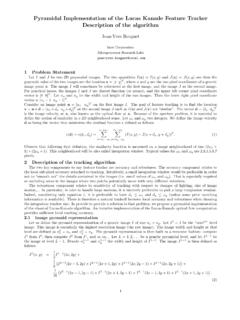Transcription of History of Robotics
1 A Brief History of Robotics ~ 350 The brilliant Greek mathematician, Archytas ('ahr 'ky tuhs') of Tarentum builds a mechanical bird dubbed "the Pigeon" that is propelled by steam. It serves as one of History s earliest studies of flight, not to mention probably the first model airplane. ~ 322 The Greek philosopher Aristotle If every tool, when ordered, or even of its own accord, could do the work that befits then there would be no need either of apprentices for the master workers or of slaves for the lords.
2 Hinting how nice it would be to have a few robots around. ~ 200 The Greek inventor and physicist Ctesibus ('ti sib ee uhs') of Alexandria designs water clocks that have movable figures on them. Water clocks are a big breakthrough for timepieces. Up until then the Greeks used hour glasses that had to be turned over after all the sand ran through. Ctesibus' invention changed this because it measured time as a result of the force of water falling through it at a constant rate. In general, the Greeks were fascinated with automata of all kinds, often using them in theater productions and religious ceremonies.
3 1495 Leonardo DaVinci designs a mechanical device that looks like an armored knight. The mechanisms inside "Leonardo's robot" are designed to make the knight move as if there was a real person inside. Inventors in medieval times often built machines like "Leonardo's robot" to amuse royalty. 1738 Jacques de Vaucanson begins building automata in Grenoble, France. He builds three in all. His first was the flute player that could play twelve songs. This was closely followed by his second automaton that played a flute and a drum or tambourine, but by far his third was the most famous of them all.
4 The duck was an example of Vaucanson's attempt at what he called "moving anatomy", or modeling human or animal anatomy with mechanics." The duck moved, quacked, flapped its wings and even ate and digested food. 1770 Swiss clock makers and inventors of the modern wristwatch Pierre Jaquet-Droz and later joined by his son Henri-Louis Jaquet-Droz start making automata for European royalty. They create three dolls, each with a unique function. One can write, another plays music, and the third draws pictures.
5 1801 Joseph Jacquard builds an automated loom that is controlled with punched cards. Punch cards are later used as an input method for some of the 20th centuries earliest computers. 1822 Charles Babbage demonstrates a prototype of his "Difference Engine" to the Royal Astronomical Society. He continues his work by designing an even more ambitious project "the Analytical Engine" that reportedly was to use punch cards inspired by Joseph Jacquard's invention. During his lifetime he never produces a functional version of either machine.
6 Despite this shortcoming he is often heralded as the "Father of the Computer" and his work lives on as the foundation for the binary numbering system that is the basis of modern computers. 1847 George Boole represents logic in mathematical form with his Boolean Algebra. 1898 Nikola Tesla builds and demonstrates a remote controlled robot boat at Madison Square Garden. 1921 Czech writer Karel Capek introduced the word "Robot" in his play (Rossuum's Universal Robots). "Robot" in Czech comes from the word "robota", meaning "compulsory labor".
7 1926 Fritz Lang's movie Metropolis is released. "Maria", the female robot in the film, is the first robot to be projected on the silver screen. 1936 Alan Turing introduces the concept of a theoretical computer called the Turing Machine. Despite being a fundamental advance in computer logic it also spawns new schools in mathematics. 1940 Issac Asimov produces a series of short stories about robots starting with A Strange Playfellow (later renamed Robbie) for Super Science Stories magazine. The story is about a robot and its affection for a child that it is bound to protect.
8 Over the next 10 years he produces more stories about robots that are eventually recompiled into the volume I, Robot in 1950. Asimov is generally credited with the popularization of the term " Robotics " which was first mentioned in his story Runaround in 1942. But probably Issac Asimov's most important contribution to the History of the robot is the creation of his Three Laws of Robotics : 1. A robot may not injure a human being, or, through inaction, allow a human being to come to harm. 2. A robot must obey the orders given it by human beings except where such orders would conflict with the First Law.
9 3. A robot must protect its own existence as long as such protection does not conflict with the First or Second Law. Asimov later adds a "zeroth law" to the list: Zeroth law: A robot may not injure humanity, or, through inaction, allow humanity to come to harm. 1946 George Devol patents a playback device for controlling machines. 1950 Alan Turing publishes Computing Machinery and Intelligence in which he proposes a test to determine whether or not a machine has gained the power to think for itself.
10 It becomes known as the "Turing Test". 1951 The Day the Earth Stood Still premieres in theaters. The movie features an alien named Klaatu and his robot Gort. 1956 Alan Newell and Herbert Simon create the Logic Theorist, the first "expert system". It is used to help solve difficult math problems. Aided by a grant from the Rockefeller Foundation John McCarthy, Marvin Minsky, Nat Rochester, and Claude Shannon organize The Dartmouth Summer Research Project on Artificial Intelligence at Dartmouth College.
